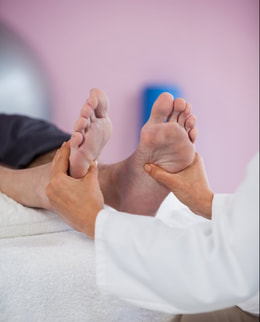 Every twelve months at the minimum, you will need a comprehensive Diabetic foot assessment. This entails testing for neuropathy, motor strength, vascular, painful foot conditions, footcare and footwear. We then communicate the findings in a report back to your physician. We provide detailed education to you on how to care for, manage and protect your feet and we also have foot care nursing on site for corns and callus removal and toe nail clipping. Additionally, we are proud to announce our Pedorthist, Katia Langton has been appointed onto the Diabetic Foot Stream Committee of the International Diabetes Federation. This committee is focused on preventing ulcers and amputations in Diabetic Foot Disease. For a comprehensive Diabetic foot assessment please call us.
1 Comment
The Plantar fascia is a ligament located on the bottom of the foot. It functions
by attaching the ball of the foot to the front of the heel. It is important in maintaining arch height and providing stability to the foot when you walk. When there are problems with the way you walk, increased stress on the fascia causes injury and subsequently pain. Biomechanical problems can include the big toe having too much movement, the foot over pronating (arch collapsing) or the ankle being restricted or stiff in its movement increasing stress on the Plantar fascia. Typically the fascia will try to repair itself when you sleep or sit for extended periods. Once you stand up and put weight on the fascia, you tear the ligament and thwart these attempts to heal the fascia. This explains why pain is often worse first thing in the morning or after standing from sitting for longer periods of time. One of the more effective solutions is to support the arch with a custom foot orthotic. Custom orthotics will limit the stretch on the Plantar fascia. Once you limit the repetitive strain on the fascia; the inflammation and the pain it causes will generally resolve over a period of 6-8 weeks. As you are correcting the biomechanics with custom orthotics, you will need to stretch the tight achilles tendon and use cold laser, ice and ultrasound to decrease inflammation and speed up healing. One of the most troublesome complications of Diabetes strikes the feet first. Elevated blood sugar damages small blood vessels in the feet which causes damage to sensory nerves.
As these nerves are dying; symptoms include throbbing, numbness, tingling or burning in the feet, the sensation of bugs crawling on your skin, and sharp, shooting pain down the legs. As we lose sensation in the feet, we lose the ability to know when our tissues are being injured. Imagine a rock in your shoe and not being able to feel it, or walking for a long time without the messages back to your brain warning you when you need to rest, get off your feet or change your footwear. Sensory neuropathy (nerves dying) destroys our ability to protect our feet from injury. The best defence against tissue damage common in peripheral neuropathy is to prevent injury in the first place. This can be done through preventative foot checks, callus removal, protective footwear and orthotics specifically for the Neuropathic foot. All people with Diabetes should have a foot screening exam at least every 12 months. Contact us today. Coverage under NIHB, DVA, Social Services and direct billing to extended benefits. Past event for Vancouver Island Diabetes Educator Section (DES) fall meeting. Took place at the The Grand Hotel Nanaimo from 8:30 AM to 3:30 PM.
Our very own Katia Langton, Certified Pedorthist spoke on Preventing the Preventable in the Global Fight Against Diabetic Foot Ulcers and Amputations. Here's the Itinerary: 0830 Registration opens: light breakfast, exhibitor booths open 0920 Welcome and Agenda 0930 Navigating diagnosis and treatment of gluten related issues or FODMAP intolerances in patients with diabetes – Joyce Schnetzler, RD, Canadian Celiac Association Professional Advisory Council, Outpatient RD @ Island Health 1045 Break 1100 GLP-1: 4 Years Later – Dr. Lucretia van den Berg, Endocrinologist, Victoria 1200 LUNCH AND NETWORKING: lunch provided, exhibitor booths open 1300 VI DES Chapter meeting and CDA updates 1400 Preventing the Preventable in the Global Fight Against Diabetic Foot Ulcers and Amputations – Katia Langton, Certified Pedorthist and Dr. Pieter Boshoff, MD, MBChB (Pretoria), International Interdisciplinary Wound Care Certificate, Co-Director of the Central Vancouver Island Foot and Ulcer Clinic. 1515 Meeting Wrap up and Evaluations 1530 Meeting Adjourned Our very own Katia Langton spoke at the American Orthotics and Prosthetic Association‘s National Assembly conference in San Antonio Texas.
Her talk was on “The Next Global Pandemic” and how diabetes, ulcers and amputations are poised to overwhelm nations and cripple health care budgets. This disease is skyrocketing globally. A critical paradigm shift in treating the diabetic foot is necessary to prepare for the increasing incidences and severity of the disease and its complications. This is the same talk Katia gave back in July at the American Podiatric Medical Association. |
Katia LangtonKatia Langton is trained as a doctor of Chiropractic. She is the owner and operator of Oceanwalk Pedorthic Footcare and is also the Secretary of the Diabetic Foot Stream Committee of the International Diabetes Federation and co-authored the latest IDF guidelines to protect The Diabetic foot from breakdown. Archives
February 2024
Categories |

 RSS Feed
RSS Feed
